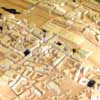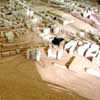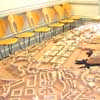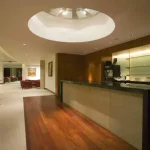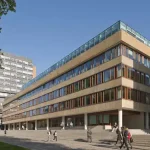Scott Sutherland Manifesto, Edinburgh Building, Architect, News, Project, Plans
Scott Sutherland Manifesto for Edinburgh
Masters Unit Programme, Scotland
22 May 2009
Manifesto for Edinburgh
News Update:
The masters degree unit at Scott Sutherland School in Aberdeen have now prepared a manifesto for Edinburgh: Towards a New Edinburgh. It is the culmination of nine months of study looking at the city and in particular the UNESCO world heritage site. The attached website contains details of 18 student projects and much more:
www.towardsanewedinburgh.co.uk
For Reference:
World Heritage Curse or Blessing
http://www.bbc.co.uk/iplayer/episode/b00kgzmw/World_Heritage_Curse_or_Blessing/
Scott Sutherland Manifesto for Edinburgh
Ian Ritchie, Roisin Heneghan and Neil Gillespie to be final reviewers
Masters unit who are working on projects in Edinburgh. The unit programme was set in October 2008 at the start of term (ref. “Theoretical Position” further down this page) but like all good students, they have moved beyond the original scope of the brief and have prepared their own Manifesto, which they are all working to:
EDINBURGH…
Edinburgh is located on the east coast of Scotland’s central belt and is the second largest city within Scotland. It is Scotland’s capital and home to the Scottish parliament. Looking at the historical development of Edinburgh, it shows a city that has grown and adapted to the needs of its occupants, often by making bold and innovative moves.
PAST…
The city of Edinburgh began in 1074 with the fortification of the topographical castle rock which had been home to fortifications since 900BC and is thought to be one of the longest occupied sites within Scotland.
The High Street developed along the ridge of the crag and tail which the castle is located, and was developed as a street that had no roads. Only closes and wynds provided access. This was done as a means of wind management which meant the High Street became a more pleasant environment to be in. The High Street was 100 foot wide and became the living room for the city. It was here that the cities’ philosophers and intellectuals met to discuss their ideas and as such became the birth place of the Scottish Enlightenment. As the street frontage on the main thoroughfare was limited the city expanded in a herringbone pattern down the closes and wynds.
Princes Street Gardens were once home to a body of water called the Nor Loch. It was created in 1460 to strengthen the castle’s defense. It began as a picturesque haven where residents of Edinburgh would boat in the summer and skate in the winter and was also a place to trial witches. Over the years it became a dumping ground for Edinburgh and the water became infested.
The resulting pollution was said to give hallucinations to the residents of the Old Town. Nor Loch was eventually drained in 1759 when the city began construction of the New Town and became a garden for the residents of Edinburgh.
Construction of Edinburgh’s New Town began in 1760’s and was done so because of a requirement for new housing for the residents of Edinburgh. The Old Town had become known as the slums due to their deteriorating and very cramped conditions. The city looked to the flat farm land to the north as a place to build a new town. The New Town was laid out in a simple grid iron arrangement and the buildings were constructed in a classical style which was very different to the Old Town.
North Bridge was constructed to connect the Old Town to the New Town and was the only connection to the New Town until the mound became a passage as well. The mound developed as waste gathered from the construction of the New Town but soon became used as a means of connecting the old and new. Up until this stage the High Street had been somewhat of an island between the location of the New Town in the north; and the university and the meadows to the south. You had to walk up and down small closes to get access.
South bridge was constructed as a means of bridging the divide to the south of the High Street. It was constructed as an inhabited bridge where the vaults that were used to construct it became home to retailers and workshops. It was once home to some of the most expensive rental land in Europe.
Edinburgh’s Cockburn and Jeffery Street’s were created to provide better access from the High Street to the train station. It was seen as a bold move as it resulted in the demolition of many tenements and the loss of closes.
Edinburgh can be viewed as a city with a split personality; a light and a dark side. The New Town with perfect proportions could be seen as the light side; and the Old Town with dark winding closes and streets as the dark side. Edinburgh is home to a number of myths and legends which highlight this fact.
The city of Edinburgh gained UNESCO World Heritage Status in 1995 and was granted for the contrast of the antique charm of the Old Town and the formal grandeur of the New Town. UNESCO is tasked with the preservation of the Edinburgh cityscape although it would appear that it is more concerned with the preservation of the cities aesthetic look.
Edinburgh has not developed this way before; it has not concerned itself with the preservation of a previous aesthetic look but has developed due to the way in which people have chosen to live their lives.
PRESENT…
Today Edinburgh is stuck in a rut. The arrival of World Heritage Status has
strangled the birth of innovative architecture. So concerned for the need to
maintain a consistent aesthetic for the city, buildings are stripped bare of all
architectural expression to reveal yet another bland sandstone creation
which will fade nicely into the background.
Edinburgh is a city which attracts over a million visitors a year, many of whom
come to visit one of the cities international festivals, such as the Fringe or
Military Tattoo. Edinburgh is a city which relies on its tourism and spending of
disposable income. As such Edinburgh needs to once again provide the
innovation it is famous for.
Edinburgh is also the financial centre for Scotland with many headquarters
situated in prominent sites throughout the city, most notably the Royal Bank of
Scotland. The UK, as well as the rest of the world, is currently experiencing a
recession. Along with a recession comes the fear of unemployment, eviction
notices, depression and worry…
What happens to Edinburgh when the money runs out?
FUTURE…
Historically Edinburgh has been a self sufficient city contained within the
boundary walls. Trading took place up and down the Royal Mile and along
the various closes that feed off the High Street including Fleshmarket Close,
Fishmarket Close, Old Brewers Close, Bakehouse Close, and Sugarhouse
Close. The presence of Farming and local food production was obviously a
key theme of living and trading within the city walls and even the New Town.
It was the late 19th, early 20th century that these were finally pushed to the
outskirts of the city. Residents originally lived amongst orchards and allotment
spaces in the New Town that were used by the local nursery men. Edinburgh
provided for its people, namely in the creation of the Nor Loch for drinking
water.
Edinburgh has set a precedent of self sufficiency that has been lost with the
commercial sprawl on the city. Returning Edinburgh to a self sufficient city will
aid several issues that are key in the world at present. The financial and
climate crisis can be reduced by focussing back on local businesses of local
produce, namely food.
The pedestrianisation of the Royal Mile will be the first
step to recreate the once vibrant market place. Retaining or reinstating all
the closes and wynds to and from the High Street as well as the creation of
links between the Old and New Towns will aid successful local food
production. This will create a local food economy that reduces the demand
on supermarkets based at the outskirts of cities.
The use of an additional tram route, circumnavigating the Old Town will help
reduce the carbon footprint of commuters and bring in people from the
periphery to take advantage of the local food production as well as general
amenities for live, work and play. With rising fuel costs, this will also ease the
financial problems associated with owning, and parking, a car in the city
centre.
The self sufficiency of Edinburgh also resulted in a densely packed and
socially mixed society. The creation of the New Town drew the elite outwards
leaving the poor in the Old Town which soon became the slums.
Patrick Geddes’ influence reinstated a mixed community in the Old Town in
the 1890s. Since, the dominance of tourism and education in the area has
resulted in a largely student and irregular society.
Currently, Edinburgh is victim to an excess of social problems. These include
3500 drug users, an increasingly ageing population, and lack of affordable
housing (of which the government propose 5000 new homes each year until
2015). As the economy in Edinburgh deteriorates there is a foreseeable need
for social services. Providing facilities for the vulnerable within the city centre,
rather than the outskirts of town will ensure that the problems are tackled
head on.
Edinburgh’s tourism generates 9.7% of all employment making this one of the
main economic contributors to the city. The main tourist attractions are
undoubtedly the festivals, the castle and the Royal Mile itself. The remainder
of the Old Town, the New Town and even the New Scottish Parliament
Building however are neglected. This is not helped by the amount of ‘tartan
tat’ shops located along the length of the Royal Mile which cheapen the
overall quality of the Royal Mile and as such prevent locals from visiting.
By expanding on Edinburgh’s and Scotland’s historical traditions in a
respectful and interesting way through for example the proper manufacturing
of the kilt, the restoration of the brewery trade, provision of a unique setting
for the Military Tattoo, reviving the film festival and providing an overall
cultural centre; Edinburgh will become a sustainable tourist base for both
locals and visitors generating a yearlong income. Spreading the tourist centre
beyond the Royal Mile will also encourage visitors to explore both Old and
New Towns as well as Princes Street Gardens.
Edinburgh has over 1500 Ha of open space which equates to 32.7m2 per
person. In comparison, London has only 20.5m2 per person. Historically open
spaces such as the Grassmarket, Princes Street Gardens and Queen Street
Gardens have been used for music evenings, orchards, markets and
recreational spaces. Somewhere in the shift of populous leaving the town
centre, Edinburgh’s open space has become underused and undervalued
often functioning as nothing more than a lunch spot in peak season.
A successful precedent is the reinvention of the Grassmarket as a cultural
space with its bars, cafes, nightlife and festival venue, extending its use into
the evening beyond daylight hours.
Similarly we aim to fully exploit Edinburgh’s forgotten asset: open space and
gardens. It needs to perform all year round in a northern climate; giving
Edinburgh’s resident community and tourists an escapism from financial woes
inhabiting and enjoying what is theirs; Edinburgh’s open space and gardens.
There has been a railway station in the Waverley Valley for over 150 years,
during which time the surrounding urban fabric had been altered and
changed. The site looks to many of Edinburgh’s most characteristic views and
structures, and is in an important position to bridge the differing urban grains
of the Old and New Towns. This importance has now been forgotten. By
redesigning the station to reconnect the Old and New towns as well as define
views of the city, a strong sense of arrival in Scotland’s Capital city will be
achieved.
“This profusion of eccentricities, this dream in masonry and living rock is not a
drop scene in theatre, but a city on the world of reality”
Robert Louis Stevenson
Theoretical Position:
Professor Alan Dunlop
Masters Unit
Scott Sutherland School, RGU
19th September 2008
“I love art, and I love history, but it is living art and living history that I love. It is in the interest of living art and living history that I oppose so-called restoration. What history can there be in a building bedaubed with ornament, which cannot at the best be anything but a hopeless and lifeless imitation of the hope and vigor of the earlier world?”
William Morris
Brief:
The unit will focus on Edinburgh, particularly the old town and we’ll be looking at creating significant new projects within the confines of a historic city, in this case a UNESCO World Heritage Site.
The restrictions imposed by Edinburgh’s city planners and a vociferous Conservation lobby has meant that new architecture within the defined world heritage area is often bland and uninspiring, with developers following a path of least objection.
Nevertheless, Edinburgh is Scotland’s capital; we all have an interest in protecting its future. It is also a living city and requires major infrastructure, transportation and cultural projects to be sustainable in the long term.
It requires new hotels, business & conference facilities to cater for the expanding tourism & financial industries
It requires sustainable places for people to work and to live.
We will seek to challenge the idea that in order for you to respect the built heritage of Edinburgh and the UNESCO World Heritage accreditation you must build new replicas of historic buildings.
We will seek to explore and encourage highly contemporary approaches for new projects based on work done in other major European cities like Copenhagen, Madrid, Berlin or Basel.
Theoretical Position – Debate:
Whilst engaging with the current debate within our profession regarding new developments within Edinburgh’s historic centre, the ambition of the unit will be to use the city as an exemplar case for how new projects can be successfully integrated into any historic urban context.
Last year we looked at Glasgow and projects placed within an industrial city that is undergoing a twenty-year strategic regeneration process.
This year we will study a more precious built environment.
The supposition of the unit will be that new projects need not be traditional in appearance + form or indeed constructed from a recognised and acceptable palette of materials in order to make a positive contribution to the quality of the urban fabric.
The unit will explore attitudes to conservationism & contemporary urban regeneration through precedent, comparison and the proposition of contemporary urban architecture. Students will carry out a detailed analysis of the historic context, becoming knowledgeable in the city development framework policies and the current design proposals for Edinburgh.
They will investigate & compare design work built or being proposed in other major European cities with a similarly rich built tradition.
The unit’s aim will be to highlight & contrast the nature of policy defined by a conservationist agenda and within other European contexts.
The broader remit will also explore the potential removal of existing or listed structures, although a tight restriction will be placed upon students when making such proposals. Decisions on the appropriateness and quality of their proposal will ensure that whatever replaces a recognised building must be of a standard that is fitting for this rich context & makes significant improvement.
Students will be encouraged to develop urban design proposals & to define their own theoretical framework for building in sensitive parts of the city
This framework will be supported by their own analysis & study.
Proposals will focus on new social housing, mixed use, transportation, commercial and public buildings, university, public realm and civic design.
How is this placed within Scott Sutherland?
The Scott Sutherland School has a reputation for producing competent designers who can offer solid practical skills and so are of benefit in a working office environment.
However, we should also be encouraging students to challenge the status quo, think rationally and independently.
They should be prepared to take a stand on contemporary issues, which are often highly contentious and be able to argue their case, with some rigour and based on a good intellectual grounding of study and research.
It is my view that such a study will better equip students within this unit to be better architects.
Edinburgh Architecture
Edinburgh World Heritage Status
Comments / photos for the Scott Sutherland Manifesto for Edinburgh Edinburgh Architecture page welcome
